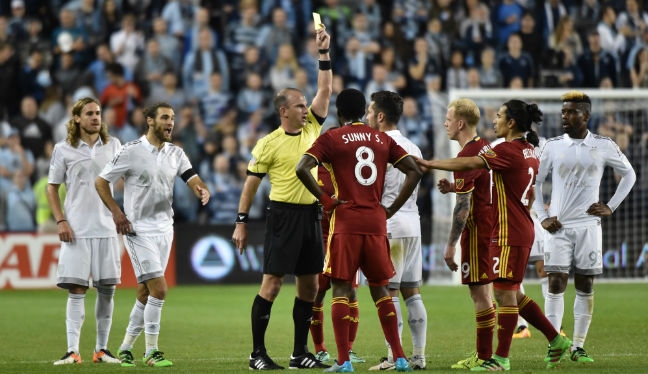Play of the Week 5: Injury stoppages and manufacturing restarts

Image: Ted Unkel shows RSL’s Luke Mulholland a yellow card.
By PRO Training & Development Manager Paul Rejer
In Play of the Week 5 we are discussing the obligation of referees and players to stop the game due to injury.
In the first play, from New England Revolution versus New York Red Bulls, you will see that when the play first starts, at 53:47, everything is normal, and when Revs’ Scott Caldwell first receives the ball he has his back to injured Red Bulls player Kemar Lawrence, who is on the ground and is the second-last defender.
Caldwell cannot see Lawrence, turns and plays the ball forward to team-mate, Juan Agudelo, who like any player is only focused on continuing to attack his opposition goal.
He then crosses the ball to Diego Fagundez, who scores the only goal of the game. Like any striker, Fagundez will only be concerned with placing the ball into goal and anything surrounding that he will not be aware of or interested in.
This causes a reaction from the Red Bulls players, who feel a sense of injustice. Furious NYRB goalkeeper Luis Robles takes his anger out on opponents and ends up receiving a yellow card from referee Mark Geiger. I can understand the frustrations of the Red Bulls players. However, do they have a legitimate complaint?
The law states that the referee “stops the match if, in his opinion, a player is seriously injured and ensures that he is removed from the field of play”. It also says that the referee “allows play to continue until the ball is out of play if a player is, in his opinion, only slightly injured”.
So it’s down to the referee’s opinion and the opponents, in law, are under no obligation to kick the ball out.
In the context of this play, as I have explained above, the New England players were unaware of any injury when the attack first developed, then Agudelo and Fagundez were totally focused and in the zone of an attacking move. Therefore, there was no evidence for Geiger to stop the game for a serious injury to a player and there was absolutely no obligation for the Revolution players to stop playing.
Furthermore, the Red Bulls defence should realise that if they push upfield then Kemar Lawrence, although on the ground, would be their second-last defender.
In the second play, in the Sporting Kansas City versus Real Salt Lake game, RSL’s Aaron Maund goes to ground injured inside the penalty area.
Referee Ted Unkel stops the game but it immediately becomes apparent that Maund is not seriously injured and Unkel, with SKC in possession of the ball, should have allowed play to continue. However, he tries to play safe and stops the game – somewhat understandable perhaps with the controversy that occurred at the Revs v Red Bulls game the night before.
Then a problem arose when Unkel tried to manufacture and manipulate the restart. He dropped the ball at Benny Feilhaber’s feet and expected and demanded that players co-operate when they have no obligation to do so.
As soon as Feilhaber has possession of the ball, play has officially restarted and Luke Mulholland has every right to challenge. When challenging, Feilhaber commits a reckless tactical foul on Mulholland and deserved to receive a yellow card from Unkel. But Mulholland also received a yellow card – he can feel unfortunate. For what? Mulholland had every right to challenge as the game was in open play and referees cannot manipulate the players to co-operate in manufacturing the restart.
It’s important that referees are aware that they only stop the game for serious injury which is often difficult for them to judge, and the only signs usually are players holding their head to indicate a head injury. Once the game is stopped, players have every right to opt to challenge for the ball in a drop ball scenario, and then once the ball is in play they are entitled to challenge for the ball.
